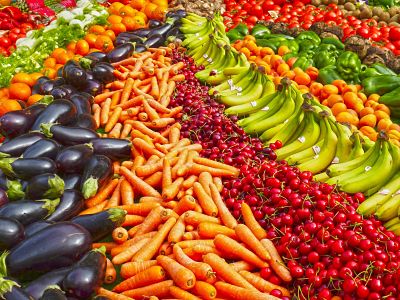So far in this series on developing good nutritional habits, we’ve covered eating whole foods instead of processed foods whenever possible, being prepared to eat every 2-3 hours and drink mainly non-calorie drinks (except when you’re sweating, obviously).
Whilst that first post provided a broad indication of what we should eat, the next three blogs in this series will go a little deeper and each will cover one of the three ‘macronutrients’; carbohydrates, proteins and fats.
We start with the athlete’s favourite. Yes, we’re talking CARBS…
Why you should eat fruit and veg with every meal
Simply put, vegetables and fruits are the best types of food we can eat for our health. Rich in fibre, vitamins, minerals, antioxidants and phytochemicals, these foods offer a whole host of health, body composition and performance benefits. Vegetables and fruits also possess a high water content which aids hydration and most tend to be alkaline producing, which helps maintain optimal blood acidity.
Their water and fibre content are also great for making us feel full and, since most vegetables and fruits tend to be low in calories, these foods are ideal for filling us up at a relatively minor calorie cost.

Now we’ve all heard of the ‘5-a-day’ recommendation for fruit and veg intake. However, at Porsche Human Performance we ramp this up a bit!
- Aim for at least EIGHT servings of vegetables and fruits every day. Only whole fruit and veggies count for this one – despite what the label says, foods like spaghetti hoops don’t quite cut it I’m afraid…
- Include at least 2, fist-sized servings of vegetables and fruits with each meal. Yes, that includes breakfast…
- Strive for a wide variety of colours. This ensures you maximise nutrient intake since the colour of fruit and veg is closely linked to the nutrients they contain.
- Emphasise veggies. Aim for a veg:fruit ratio of 3:2 if you are active and 4:1 on days you’re sedentary. This is linked to the higher carb content of fruits vs veggies and the idea of matching carb intake to activity level – more on that later.
What are the other carb sources I should consider?
Now that we’ve validated grandma’s advice of eating all your greens, it’s time to address the elephant in the room. Since you read this blog’s title, you’ve probably been thinking “Wait a minute, get all my carbs from veggies?! What about breads and pasta, gels and powders?!”
Let me explain. Firstly, note the wording here; we’re not saying fruit and veg should be your your only carbohydrate source. We certainly advocate eating a wide variety of carbs, but making fruits and vegetables a staple in this regard carries several major benefits.
Also, all of the habits in this series focus more on our everyday nutrition than the nitty gritty of exercise nutrition. That said, for most people we see at PHP, nailing your day-to-day nutrition is one of the best ways of maximising your training and competition performance.
These days, the typical ‘Western’ diet tends to be very calorie-dense and nutrient-sparse. This has a lot to do with the growing abundance of processed foods, especially refined carbohydrates like sugary drinks and breakfast cereals, cakes, sweets, biscuits, crisps, chips, pastries, white breads and pastas.
At PHP, we strongly believe that one of the best ways to reverse the calorie dense, nutrient sparse trend is to address dietary carbohydrates. Specifically, we mean increasing the contribution of vegetables, fruits and other unrefined, whole foods at the expense of the more processed alternatives listed above.
Unrefined carb sources we recommend to our athletes include:
- Starchy vegetables e.g. potatoes, sweet potatoes, carrots, parsnips, celeriac, beetroot
- Fruits e.g. bananas, grapes, apples, oranges, pears, pineapple, mango, berries
- Beans/pulses/legumes e.g. kidney/cannellini/butter beans, chickpeas, lentils, frozen peas
- Whole grains e.g. oats, brown rice, quinoa, sweetcorn
Stick to these whole-food forms of carbohydrate instead of the more processed staples of our modern diets and you’ll go a long way to maximising the nutritional value of your diet.
How to individualise your carbohydrate intake
As with your electrolyte needs, there’s no ‘one-size-fits-all’ approach when it comes to the optimal amount of carbohydrate to consume per day. Several factors influence our carbohydrate requirements but your physical activity level is perhaps most important.
Considerations worth making when looking to individualise your carbohydrate intake based on your physical activity include…
- Training frequency – people with higher training frequencies will need more carbohydrate to aid recovery between sessions.
- Training intensity – since higher training sessions rely on carbohydrate as the main fuel source, our carbohydrate requirement increases around periods of intense training versus periods of low intensity training.
- Training duration – unless you’re deliberately manipulating carbohydrate availability, higher carbohydrate intakes are often appropriate around prolonged (>90 min) training sessions.
- Non-exercise activity – when training level is equated for, those with active jobs and pastimes will have higher carbohydrate requirements than those with sedentary jobs and pastimes. (Duh!)
On days when you think your carb intake needs to be higher, include more starchy vegetables, fruits, beans, pulses, legumes and/or whole grains in your meals.
On days when you think your carb intake should be lower, replace these foods with green/less starchy vegetables and/or higher fat foods (more on these in a future post).
For example, porridge with chopped banana (higher carb day) vs spinach, mushroom and tomato omelette (lower carb day); roast chicken with baked sweet potato and peas (higher carb day) vs roast chicken salad (lower carb day).
Buy yourself a vegan cookbook or look up vegan recipes online. Vegan chefs tend to do a great job of bringing out the best in vegetables and can give you some great ideas for how to jazz up what might otherwise be the boring part on the side of the plate. Then, if you’re an omnivore like me, add some meat or fish to the dish and away you go!
Speaking of meat and fish, the next post in our series covers another crucial part of our diets, and one that a lot of people could do with eating more of…protein. Stay tuned.
